This article needs additional citations for verification .(September 2014) |

The American Watercolor Society, founded in 1866, is a nonprofit membership organization devoted to the advancement of watercolor painting in the United States.
This article needs additional citations for verification .(September 2014) |

The American Watercolor Society, founded in 1866, is a nonprofit membership organization devoted to the advancement of watercolor painting in the United States.
AWS judges the work of a painter before granting admission to the society as an "active" (now "signature") member. Such membership in the society now is considered an indication of the painter having established a consistent style and to have demonstrated considerable skill in the medium. Transparency in the works of water color painters is highly valued. That is a technique wherein the paper surface is allowed to show through the applied paint as an integral aspect of the painting. The applicant usually must demonstrate a history of winning prizes in juried art shows with professional standing to gain admission. This type of membership in the society, generally, is signalled by "AWS" following the painter's name in promotional materials and biographies. Membership by others is indicated as an "associate" status.
The society was founded in 1866 by eleven painters and was originally known as the American Society of Painters in Water Colors. [1] Initially, it was difficult to draw in new members, partially because some artists of the time opposed the society's policy of allowing women to join. [2] The New York Watercolor Club merged into the society in 1941.



The New York Water Color Club (NYWC) was founded in 1890, accepting both men and women artists as members and officers, and held its first exhibition that year. [3] Childe Hassam was the organization's first president. NYWC was organized in response to refusal by the American Watercolor Society (AWS) to accept women members and to organize an annual exhibition in the fall. In comparison to AWS, it held jury-selected exhibitions which meant stricter standards for the content included in its shows. [4] The club had male and female members and officers, whereas the American Watercolor Society did not accept women as members of their organization until 1897. [5] [6]
Its headquarters and site of its annual exhibition was in the American Fine Arts Building at 215 West 57th Street. [nb 1] The club was represented in the Fine Arts Federation of New York [8] and with other art and architectural organizations on the board of the National Academy Association. [9] In 1918, the club had 175 members and exhibited 581 works by 301 artists in its annual exhibition. Of the 581 works of art, 501 of were watercolors. [8]
The club combined exhibition venues with the American Water Color Society between 1922 and 1931. The two organizations merged, having created a new constitution, and was named the American Watercolor Society in January 1941. [5] The effort was led by Roy Henry Brown, president of the American Watercolor Society. [10]
Its records are archived at the Smithsonian Archives of American Art. [3]
Catherine Tharp Altvater (1907–1984) was the first woman to hold office in the society. In 2008 Jim McFarlane took over presidency from Janet Walsh.
Influential members within the organization were:
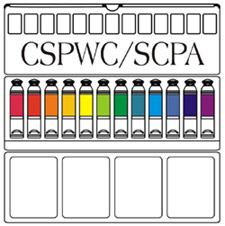
The Canadian Society of Painters in Water Colour, founded in 1925 is considered to be Canada's official national watercolour Society. Since the 1980s the Society has enjoyed Vice-regal Patronage from the incumbent Governor-General of Canada. Recognized by a long list of international exhibitions it is the Canadian equivalent of such other national societies as the American Watercolor Society of the United States, the Royal Watercolour Society of the United Kingdom, etc.
Ruth Van Sickle Ford was an American painter, art teacher, and owner of the Chicago Academy of Fine Arts. She credited artists George Bellows, who influenced her interest in social realism, and John Carlson, who founded the School of Landscape Painting in Woodstock, New York, with helping her to develop her talent. She traveled and made paintings in the United States, Caribbean and South America. An award-winner, her works are in many permanent public and private collections. A book has been written about her entitled Warm Light, Cool Shadows: The Life and Art of Ruth Van Sickle Ford.
Eda Nemoede Casterton was an American painter known specifically for her portrait miniatures in watercolor, pastels and oil. She exhibited works at the Paris Salon and the San Francisco Panama–Pacific International Exposition of 1915, among others. Her works are at the Smithsonian American Art Museum and the Brooklyn Museum.

Ng Woon Lam (黄运南) is a full member of National Watercolor Society NWS and American Watercolor Society.
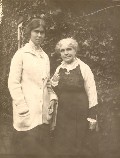
Hilda Belcher was an American artist known for her paintings, watercolors, portraits, and illustrations depicting individuals and landscapes, both in formal portraiture and in casual scenes of children and daily life. She was the second woman to be accepted into the National Academy of Design. In 1935, Anne Miller Downes, a reviewer for The New York Times, called Belcher was "one of the most distinguished women artists in America".

Florence Esté was an American painter in oils born in Cincinnati, Ohio. She also worked in watercolors, pastels, and as an etcher and engraver. She was particularly well known for her landscapes, which were said to have been influenced by Japanese artworks and were noted for their "harmony of color". Her obituary in the New York Times referred to her as "one of the best known women landscape painters."
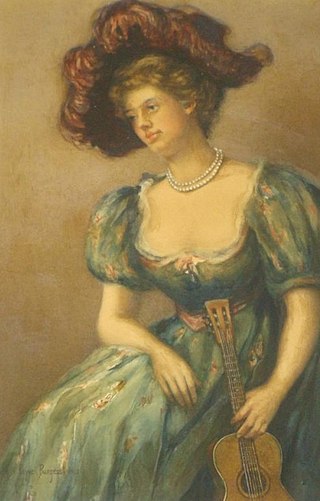
Ruth Payne Burgess,, was a naturalistic painter of portraits, still lifes, and genre work.
The Woman's Art Club of New York was founded in New York City in 1889 and provided a means for social interaction and marketing of women's works of art. The club accepted members from the United States and abroad. In 1913, the group changed its name to the National Association of Women Painters and Sculptors. The current name for the group is the National Association of Women Artists, which was adopted in 1941.
The New York Watercolor Society, also known as the New York Water Color Society, was a "short-lived" organization founded in 1850 by in part by John William Hill. It led to the founding of the American Watercolor Society in 1866.
Carol H. Beck (1859-1908) was an American historical painter, critic and writer.
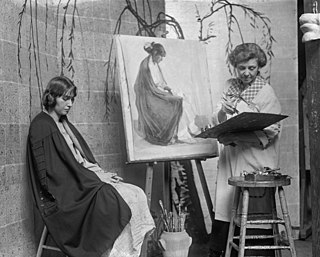
CatharineCarter Critcher was an American painter. A native of Westmoreland County, Virginia, she worked in Paris and Washington, D.C. before becoming, in 1924, a member of the Taos Society of Artists, the only woman ever elected to that body. She was a long time member of the Arts Club of Washington.

Cecil Jay (1883–1954) was an Anglo-American painter, mainly of portraits and miniatures.
Adelaide Deming was an American painter, associated for much of her life with Litchfield, Connecticut. She was the 1908 winner of the Beal Prize for her watercolor Moon Shadows.

Agnes Dean Abbatt of New York was a painter of floral still lifes, landscapes, and coastal scenes. She was the second woman elected to the American Watercolor Society.
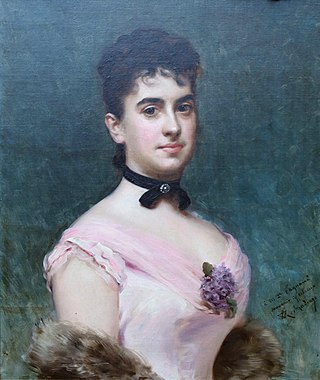
Nina Fagnani (1856–1928) was an American-born French painter of portrait miniatures.
Donna N. Schuster was an American easel painter, who created work in the style of modern impressionism using the medium of oil and watercolor. She focused her work in Wisconsin then later moved to Los Angeles, California where she died in 1953.
Bertha Eversfield Perrie was an American painter. She has been described as "about the only famous Washington artist who was actually born in D.C."

Anne Steele Marsh (1901–1995) was an American painter and printmaker whose watercolors, oil paintings, and wood engravings were widely exhibited and drew critical praise. She was also a noted educator and arts administrator.
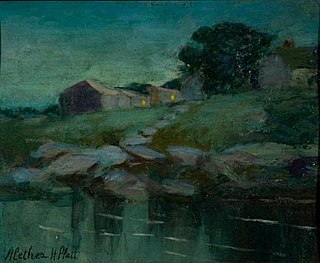
Alethea Hill Platt was an American artist and educator. Her paintings of rural landscapes in France, England, the Adirondacks, and New England were displayed in about 200 exhibitions at venues including the National Academy of Design, Pennsylvania Academy of the Fine Arts, and Louisiana Purchase Exposition. The New York Times found a "quality of serenity, even a kind of nobility" in her work, and American Art News placed her "in the ranks of America's leading women painters."
Edward Howard Betts was an American painter, collagist, author, and teacher. He was known for his abstract paintings which he developed using an improvisational method. He was also an accomplished painter of realistic watercolors. Betts published three instructional books on painting and taught at the University of Illinois.